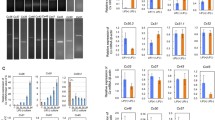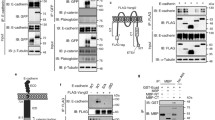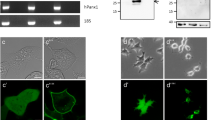Abstract
We have previously shown that intracellular trafficking and function of connexin (Cx) 26 and Cx43 are controlled by E-cadherin. In the present study, we attempted to determine which part of Cx43 is involved in this control mechanism. Since Cx26 has a very short C terminus in the cytoplasm, we hypothesized that the C-terminal domain may not be important for this process and, indeed, found that green fluorescence protein (GFP)-tagged Cx43ΔC (deleted from the codon 239) moved to the plasma membrane both in P3/22(E), a mouse papilloma cell line which expresses E-cadherin, and HeLa cells only at high calcium culture conditions. We then found that the GFP-tagged Cx43(CL 26)ΔC mutant, in which the cytoplasmic loop domain of Cx43 was exchanged with that of Cx26, remains in the cytoplasm in HeLa, HeLaCx43 and P3/22(E) cells, suggesting the importance of the cytoplasmic loop domain. In order to determine which part of the cytoplasmic domain plays a key role, we introduced four deletion mutations (deletion of codons 101–111 [mutant D1], 120–130 [D2], 131–137 [D3] or 146–159 [D4]) to the GFP-tagged Cx43ΔC gene. When these mutants were transfected into HeLa cells, D1 and D4 mutants were localized in the cytoplasm, while D2 and D3 were found in the plasma membrane only in high Ca2+ medium. However, none of these four mutants recovered gap junctional intercellular communication (GJIC). On the other hand, when these mutants were transfected into HeLaCx43 and P3/22(E) cells (which express functional Cx43), D1, D2 and D3, but not D4, moved to the plasma membrane and colocalized with endogenous Cx43 in high Ca2+ medium; all of these mutants showed a dominant negative effect on GJIC in HeLaCx43 cells. Further deletion studies indicated that the critical amino acids involved in this intracellular trafficking of Cx43 lie between codons 100 and 102.





Similar content being viewed by others
References
Bruzzone R, Gomes D, Denoyelle E, Duval N, Perea J, Veronesi V, Weil D, Petit C, Gabellec MM, D’Andrea P, White TW (2001) Functional analysis of a dominant mutation of human connexin26 associated with nonsyndromic deafness. Cell Commun Adhes 8:425–431
Bruzzone R, White TW, Scherer SS, Fischbeck KH, Paul DL (1994) Null mutations of connexin32 in patients with X-linked Charcot-Marie-Tooth disease. Neuron 13:1253–1260
Enomoto T, Martel N, Kanno Y, Yamasaki H (1984) Inhibition of cell communication between Balb/c 3T3 cells by tumor promoters and protection by cAMP. J Cell Physiol 121:323–333
Fu CT, Bechberger JF, Ozog MA, Perbal B, Naus CC (2004) CCN3 (NOV) interacts with connexin43 in C6 glioma cells: possible mechanism of connexin-mediated growth suppression. J Biol Chem 279:36943–36950
Giepmans BN, Moolenaar WH (1998) The gap junction protein connexin43 interacts with the second PDZ domain of the zona occludens-1 protein. Curr Biol 8:931–934
Hernandez-Blazquez FJ, Joazeiro PP, Omori Y, Yamasaki H (2001) Control of intracellular movement of connexins by E-cadherin in murine skin papilloma cells. Exp Cell Res 270:235–247
Ise K, Omori Y, Katoh F, Yamasaki H (2004) Control of connexin26 (Cx26)-mediated growth suppression of HeLa cells by the Cx26-specific binding protein, AP26. Proc Am Assoc Cancer Res 45:86
Jongen WMF, Fitzferald DJ, Asamoto M, Piccoli C, Slaga TJ, Gros D, Takeichi M, Yamasaki H (1991) Regulation of connexin 43-mediated gap junctional intercellular communication by Ca2+ in mouse epidermal cells is controlled by E-cadherin. J Cell Biol 114:545–555
Kawasaki Y, Miyoshi S, Yamasaki H (2004) Mechanism of connexin 43-mediated growth control; possible involvement of connexin43-associated proteins. Proc Am Assoc Cancer Res 45:82
Kelsell DP, Dunlop J, Stevens HP, Lench NJ, Liang JN, Parry G, Mueller RF, Leigh IM (1997) Connexin 26 mutations in hereditary non-syndromic sensorineural deafness. Nature 387:80–83
Kostin S, Hein S, Bauer EP, Schaper J (1999) Spatiotemporal development and distribution of intercellular junctions in adult rat cardiomyocytes in culture. Circ Res 85:154–167
Kumar NM (1999) Molecular biology of the interactions between connexins. Novartis Found Symp 219:6–16
Laird DW (2005) Connexin phosphorylation as a regulatory event linked to gap junction internalization and degradation. Biochim Biophys Acta 1711:172–182
Maass K, Ghanem A, Kim JS, Saathoff M, Urschel S, Kirfel G, Grummer R, Kretz M, Lewalter T, Tiemann K, Winterhager E, Herzog V, Willecke K (2004) Defective epidermal barrier in neonatal mice lacking the C-terminal region of connexin43. Mol Biol Cell 15:4597–4608
Matsuda T, Fujio Y, Nariai T, Ito T, Yamane M, Takatani T, Takahashi K, Azuma J (2006) N-cadherin signals through Rac1 determine the localization of connexin 43 in cardiac myocytes. J Mol Cell Cardiol 40:495–502
Mege RM, Matsuzaki F, Gallin WJ, Goldberg JI, Cunningham BA, Edelman GM (1988) Construction of epithelioid sheets by transfection of mouse sarcoma cells with cDNAs for chicken cell adhesion molecules. Proc Natl Acad Sci USA 85:7274–7278
Mese G, Londin E, Mui R, Brink PR, White TW (2004) Altered gating properties of functional Cx26 mutants associated with recessive non-syndromic hearing loss. Hum Genet 115:191–199
Meyer RA, Laird DW, Revel JP, Johnson RG (1992) Inhibition of gap junction and adherens junction assembly by connexin and A-CAM antibodies. J Cell Biol 119:179–189
Milks LC, Kumar NM, Houghten R, Unwin N, Gilula NB (1988) Topology of the 32-kd liver gap junction protein determined by site-directed antibody localizations. EMBO J 7:2967–2975
Moreno AP, Chanson M, Elenes S, Anumonwo J, Scerri I, Gu H, Taffet SM, Delmer M (2002) Role of the carboxyl terminal of connexin43 in transjunctional fast voltage gating. Circ Res 90:450–457
Moriyama M, Omori Y, Ishizaki Y, Nishikawa Y, Tokairin T, Ogawa J, Enomoto K (2003) Connexin26-mediated gap junctional communication reverses the malignant phenotype of MCF-7 breast cancer cells. Cancer Sci 94:501–507
Nelis E, Haites N, Van Broeckhoven C (1999) Mutations in the peripheral myelin genes and associated genes in inherited peripheral neuropathies. Hum Mutat 13:11–28
Omori Y, Yamasaki H (1998) Mutated connexin43 proteins inhibit rat glioma cell growth suppression mediated by wild-type connexin43 in a dominant-negative manner. Int J Cancer 78:446–453
Paznekas WA, Boyadjiev SA, Shapiro RE, Daniels O, Wollnik B, Keegan CE, Innis JW, Dinulos MB, Christian C, Hannibal MC, Jabs EW (2003) Connexin 43 (GJA1) mutations cause the pleiotropic phenotype of oculodentodigital dysplasia. Am J Hum Genet 72:408–418
Ressot C, Gomes D, Dautigny A, Pham-Dinh D, Bruzzone R (1998) Connexin32 mutations associated with X-linked Charcot-Marie-Tooth disease show two distinct behaviors: loss of function and altered gating properties. J Neurosci 18:4063–4075
Sohl G, Willecke K (2003) An update on connexin genes and their nomenclature in mouse and man. Cell Commun Adhes 10:173–180
Toyofuku T, Yabuki M, Otsu K, Kuzuya T, Hori M, Tada M (1998) Direct association of the gap junction protein connexin-43 with ZO-1 in cardiac myocytes. J Biol Chem 273:12725–12731
Wang HL, Chang WT, Yeh TH, Wu T, Chen MS, Wu CY (2004) Functional analysis of connexin-32 mutants associated with X-linked dominant Charcot-Marie-Tooth disease. Neurobiol Dis 15:361–370
White TW (2000) Functional analysis of human Cx26 mutations associated with deafness. Brain Res Brain Res Rev 32:181–183
Willecke K, Eiberger J, Degen J, Eckardt D, Romualdi A, Guldenagel M, Deutsch U, Sohl G (2002) Structural and functional diversity of connexin genes in the mouse and human genome. Biol Chem 383:725–737
Yancey SB, John SA, Lal R, Austin BJ, Revel JP (1989) The 43-kD polypeptide of heart gap junctions: immunolocalization, topology, and functional domains. J Cell Biol 108:2241–2254
Yeager M, Gilula NB (1992) Membrane topology and quaternary structure of cardiac gap junction ion channels. J Mol Biol 223:92–48
Author information
Authors and Affiliations
Corresponding author
Rights and permissions
About this article
Cite this article
Nambara, C., Kawasaki, Y. & Yamasaki, H. Role of the Cytoplasmic Loop Domain of Cx43 in Its Intracellular Localization and Function: Possible Interaction with Cadherin. J Membrane Biol 217, 63–69 (2007). https://doi.org/10.1007/s00232-007-9032-1
Received:
Accepted:
Published:
Issue Date:
DOI: https://doi.org/10.1007/s00232-007-9032-1




